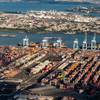Specialised Reefer Container Operators can Thrive: DMR
Despite growing competition from container lines, specialised reefer operators can still thrive, according to Drewry’s latest Reefer Shipping Market Annual Review & Forecast, referred to here in an extract from DMR's latest 'Container Insight Weekly'.
Specialised reefer operators peaked some years ago in terms of cargo volumes and are now having to contend with falling volumes and market shares as container lines move further into their territory. However, this does not necessarily mean they cannot survive and looking at the limited number of public companies reporting financial returns, profitability is indeed achievable.
To protect their future viability, specialised reefer companies must now reinvent themselves to protect their undoubted expertise in this field.
Seatrade, the world’s largest specialised reefer operator, is leading the way and has started taking on the container lines at their own game. Firstly, by lengthening its existing specialised reefer vessels with a fully cellular hold and secondly through the purchase of new reefer containerships.
Seatrade has a fleet of 67 vessels, providing over 46 million cubic feet of on-deck and under-deck capacity, a reduction of 9% on its capacity levels of just one year ago. Nevertheless, the company still controls around 20% of the world specialised reefer fleet capacity of vessels greater than 100,000 cubic feet.
In June, the operator announced the acquisition of two 2,200 teu newbuilds for around $30 million each. The vessels are of an “eco-design” and are equipped with a high reefer capacity that equates to approximately 12,000 pallets. The vessels are scheduled for delivery from the Yangfan Group’s shipyard in China in January 2016.
Seatrade’s MD also hinted of more to come, when he said that this was “just the start of a series.”
Container lines have been attracted to the reefer sector by the enticement of higher rates and strong cargo growth. Drewry’s latest analysis predicts that total seaborne perishable reefer trade will increase by 17% between 2013 and 2018, providing an additional 16.5 million tonnes of cargo.
Inevitably, this growth will be accommodated by reefer containerships as the specialised reefer sector is shrinking due to the scrapping of the aging fleet and a virtually empty order book.
The growing interest from container lines in the reefer market is something to watch out for as greater competition could suppress rates, or at the very least slow the rate of increase. Furthermore, lines always want to hold on to reefer market share, which detracts from the success rate of reefer GRIs.
The report also highlights how container lines have switched to leasing, rather than owning, containers; virtually all containerised reefer cargo moves in 40ft high cube containers. A reported 70% of new equipment orders is now being placed by container lessors, up from 40% at end-2013. Whether this lack of investment by container operators becomes significant in terms of lack of operational control, cost or localised equipment shortages, remains to be seen.
Drewry's View
Container lines will continue to grow their share of the enticing reefer market at the expense of the specialised carriers, so the latter need to diversify to protect themselves.
(Reefer Shipping Market Annual Review and Forecast is published annually by Drewry Maritime Research and is priced at £1,495).
Source: Drewry Maritime Research













